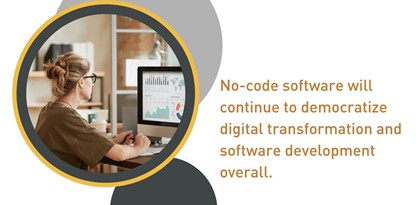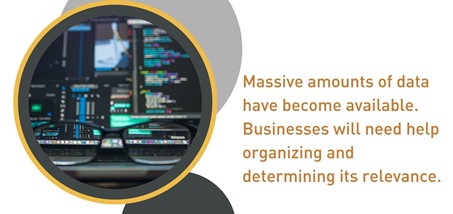
Digital transformation has increased in response to the challenges posed by the pandemic. Business leaders are implementing new technologies and leading the charge towards faster-than-ever digitization in order to meet customer needs and improve business performance.
Looking to gain a competitive advantage in the coming year? Let’s cover 50 of the top digital transformation trends to consider in 2022.
1. No-code software will continue to democratize digital transformation and software development overall. As the challenges of digitization persist, no-code solutions will see more use.
2. Low-code software will also become more prominent. However, ease of use will continue to challenge organizations where developer talent remains in short supply.

3. Developers’ responsibilities will shift to prioritizing innovation and growth. Low-code and no-code tools will assist with their workloads and help cover more mundane programming tasks for developers and business users.
4. Data analytics will help supply chain management. Detecting issues in real-time and optimizing responses will help avoid severe disruption.
5. Data-driven approaches to the customer experience will continue to be on the rise. Businesses and consumers now prefer digital channels and it’s unlikely that the use of digital will wane even after the pandemic subsides. This provides more access to personal data and increases the risk of data breaches.
6. Social media and other digital marketing channels will see an increased focus. Customers have new levels of access to businesses through increased digitization. This mode of operation and connection with businesses is now expected.
7. Contactless solutions and digital payments will continue to see a dramatic increase. Because contactless solutions, such as “tap-to-pay” payments and contactless dining, help to reduce person-to-person contact in commerce, customers are beginning to expect them everywhere.
8. Mobile-first business strategies will have more relevance. Consumers use smart devices to access the internet and applications more often. Focusing on mobile solutions, including providing services through SMS, is a reasonable investment.
9. AI ethics committees are becoming more common. The increased use of artificial intelligence in the workplace will require audits to ensure responsible use.
10. Collaboration software and hardware tools will see new investments and advancements. Technology like smart cameras and AI solutions will make remote collaboration more efficient.
11. Infrastructure for supporting Internet of Things (IoT) will see increased implementation. More devices than ever are connected to the internet and play a fundamental role in everyday life.
12. Protecting consumer data will become a more prominent issue. Increased digital connectivity will inspire calls for increased security from consumers.
13. Generative AI creates new content by utilizing algorithms that reference existing content. This technology is currently used in healthcare and will continue to expand.
14. Autonomic Systems and self-managing software will become more valuable. Systems that have built-in self-learning and optimization help respond to new challenges.
15. Decision Intelligence systems will find more widespread use. Automated processes help bolster human intelligence for more quick and efficient decision-making.
16. Composable Applications and Business Models will become the standard. Structuring for composability helps contribute to speed, resilience, and responsiveness in business operations.
17. Cybersecurity Meshes will become more popular. Digitization increases points of vulnerability for a business. Cybersecurity meshes ensure better protection on an individual basis.
18. Total Experience strategies will have an increased focus. This interlinked approach helps improve the response to all stakeholders of the business, both internal and external.
19. Hostile-tech will become more of a responsibility for companies. Examine business practices to ensure that tech solutions do not cause harm.
20. “Headless tech” will see an increase in use. This technology helps businesses separate the user experience (the frontend or “head”) from the business logic (the backend) of their platforms so companies can easily change or alter the “head” without causing unwanted changes to the backend. This allows companies to adapt to the continually changing preferences of customers.
21. Strategic Partnerships will see more relevance. Businesses reduce costs by collaborating with complementary companies. Together they can build platforms and even create new business models. This is likely to include engagements between industry incumbents and startups.
22. Quantum Computing will be a more common topic of discussion. Emerging technologies may soon be able to handle extreme amounts of data.
23. IT budgets will increase considerably. The pandemic has created a need for more innovative digital solutions. Businesses will need to increase their IT spending to accommodate them.
24. The future of work will be more remote than ever. Work-from-home scenarios will continue to rise as employees desire more freedom in choosing where and how they work.

25. Hybrid work should also gain more popularity. Some businesses will see more shifts to at-home and geographically distributed work. Yet, there is also a growing number of employees who want to return to an office environment.
26. Hyperautomation, including robotic process automation (RPA), will become an even more prominent business strategy. Automating simple and mundane tasks and business process steps is the goal of these automation trends. Then, more intense focus and human resources can be dedicated to complicated objectives.
27. Ransomware attacks have become a more prominent threat to cybersecurity. Businesses should consider these risks as they develop their cybersecurity approach in 2022.
28. Live video for e-commerce will become more prominent. Consumers will look for opportunities to replicate the in-person experience with digital technologies.
29. Cloud computing will continue to enable flexibility. There is the opportunity for experimentation, scalability, and quick deployment without risky IT investments.
30. Data-based decision-making bolstered by AI and Machine Learning will become more prominent. Where intuition falls short, hard data and pattern matching can succeed.
31. The “metaverse” will generate ongoing controversy. There are still questions as to the value of streamlining remote employee communication and accommodating new modes of interaction with customers but there is optimism around the tech.
32. Salaries and compensation for IT talent will increase. Businesses will focus on finding the best talent to oversee their digital transformation efforts.
33. CIOs may take over more CEO responsibilities. Technology leaders will become more necessary for a future-focused business outlook.
34. Blockchain will see increased relevance. It may be used to help manage digital assets as well as for authentication and data integrity.
35. Sustainability goals will be at the forefront. Companies emphasize sustainable technology design to serve environmental goals.
36. Data quality issues will become a more important talking point. Massive amounts of data or “big data” have become available. Businesses will need help organizing and determining its relevance.

37. Open-source software will see more adoption. Businesses will attempt to create the ideal solutions for their unique business requirements — though increased deployments will necessitate increased diligence around FOSS sources and licensing.
38. Education requirements may have less of a focus. Companies will value proven tech skills as an alternative to a traditional degree.
39. Augmented Reality will see more implementation. Especially in areas of business training and customer interaction. Other applications already include supply chain and inventory management.
40. 5G technology will become more prevalent. This will allow digital initiatives including remote work to achieve higher performance and access to a larger talent pool.
41. Customer Data Platforms will see more use. Leveraging knowledge on individuals is more desired as data availability has increased.
42. No-touch and contactless solutions will see more use. Customers have become accustomed to these options during the pandemic.
43. Digital payment options will expand. Businesses integrate these payment initiatives to help enable access to the digital economy.
44. Business technologists will see an increased role in IT departments. They will act as advisors responsible for overseeing sustained innovation and digitization. Business analysts will have a similar role in business units.
45. “A single source of truth” will become a prominent idea. Businesses will continue to focus on providing a primary source where consumers can gather relevant information. It helps avoid frustration with extraneous data.
46. Subscription-based business models will become more popular for technology as well as everyday activities such as primary physician care. Consumers find more value in a pay-as-you-go model, rather than one-time product purchases.
47. Multi-cloud architecture will see more use. By distributing data, software, and applications across two or more cloud services, businesses can increase their storage and computing ability. Multi-cloud systems give businesses more flexibility and better prepare them for disasters and outages.
48. Smarter Chatbots will be implemented in e-commerce solutions. Improving their conversational and data gathering abilities is key.
49. Agility as a goal in business operations will see an increased focus. Changing markets, fast-moving regulations, new opportunities, and security threats are potential challenges. Businesses will need a swift and effective ability to respond.
50. Disaster recovery and business continuity should see increased investment. The challenges of digitization require a prepared business. This means being ready to accommodate unforeseen complications without severe disruptions.
Conclusion
Remote connectivity for work and consumer interaction have been dominating technology trends. The pandemic has made these goals even more pronounced.
Moving into the New Year, these goals will still be relevant. But automation will once again rise to the most prominent point of discussion.
The standards for a successful business will continue to change. The most relevant enterprises will focus on IT investment and democratization. And, ultimately, the speed at which you digitize and adapt will determine your growth.


